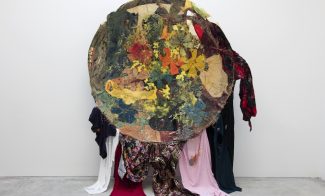New York-based Kevin Beasley uniquely combines sound and clothing—his core artistic materials—in stunning, densely packed sculptures and immersive acoustic installations. His work involves the appropriation and recontextualization of found objects, sounds, and symbols to explore how personal memory and lived experience intersect with broader examinations of power and race.
Phasing (Ebb) brings together Beasley’s signature use of colorful, patterned housedresses dipped in resin with his incorporation of environmental sounds. One of the artist’s “ghost” sculptures, Phasing (Ebb) features a cluster of figures that move outward into the viewers’ space. Beasley creates his ghost sculptures by laying clothing impregnated with resin over molds, which once removed leave striking, swooping forms without bodies or faces but filled with air and light. Beasley has also added a sound element to this sculpture. A microphone placed at a distance from the wall-mounted sculpture picks up the conversations of visitors and the ambient sound of the environment. Nearby equipment placed on the floor processes these sounds and emits them from speakers hidden within the sculpture. The distorted sounds ebb and flow—as the title suggests—connecting viewers in different locations. In combining the sounds of distant visitors with the absent bodies of the ghost sculptures, Phasing (Ebb) invites mediations on presence and absence—especially as they inform the practices and histories of representation.
This work introduces a new artist to the ICA/Boston’s collection and demonstrates the museum’s commitment to Beasley at an early moment in his career—something the institution has done since its founding. In addition to presenting Beasley’s work as part of the traveling group exhibition When the Stars Begin to Fall in 2015, the ICA is mounting a solo exhibition of Beasley’s work. Phasing (Ebb) offers a new dimension to the collection’s strength in figurative sculpture, joining works by Louise Bourgeois, Rachel Harrison, and Doris Salcedo, among others, and expands the museum’s capacity to narrate how artists employ found objects.
2017.20

